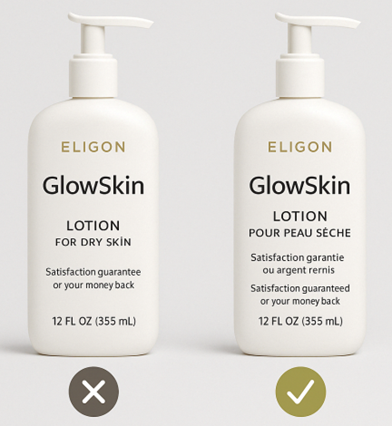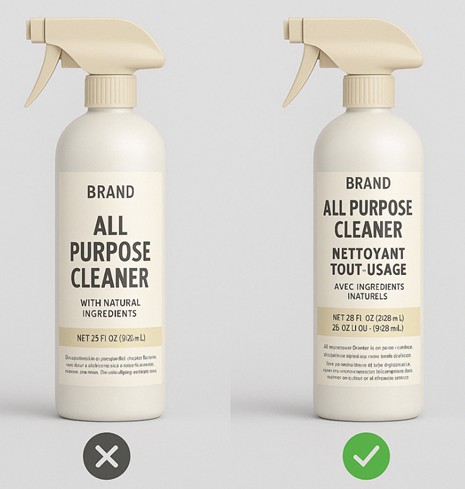Here’s a French corgi outside a French café with a flyer in French in its basket.
So… what’s all the Frenchie about?
Starting June 1, French may no longer be optional — it could be required by law. New rules are coming to Québec, and trademarks, packaging, and signage all need to be ready to parler français (that means “speak French” in French).
Summary of the Legal Change
- Effective June 1, 2025, trademarks that appear on product packaging, labeling, or accompanying materials may still be displayed in a language other than French (i.e., English) only if no corresponding French version of the trademark is registered with the Canadian Intellectual Property Office (CIPO).
- Additionally, if the non-French trademark contains “generic terms” or “product descriptions,” those elements must be translated into French and displayed permanently on the product or its packaging.
- A transition period runs through June 1, 2027 for inventory that was manufactured before June 1, 2025 and does not have a French trademark registered as of June 26, 2024.
Bottom line: Québec wants to make sure French is the dominant language (i.e., no other language is more dominant than French)
General Rule
For all products sold in Québec, the following elements must be displayed in French:
- Inscriptions on the product itself
- Text on containers, labels, and wrapping
- Accompanying materials such as instructions, manuals, warranty cards (whether physical or digital, e.g., QR codes)
Question that matters to brands: Can you continue using your trademark which is in English in Quebec after June 1, 2025?
Questions for Brands: Is Québec Compliance Required for Your Brand?
- Step 1: Is Québec an important market for your brand?
- Step 2: Do you have a French version of your trademark pending/registered (or even withdrawn/abandoned) in Canada? If yes, you must use the French version.
- Step 3: If not, is your trademark qualified for the exception (discussed below)? Review and consider the impact (where you might need to make a change) specifically on product packaging/labeling, advertising and signage.
Key Exceptions to the French Language Rule (i.e., When One Can Continue Using English):
- “Product Name” Exception: A product name, even if descriptive or generic, does not need to be translated to French (regardless of being a trademark or not)
- “Registered Trademark” Exception: This refers to the exception that allows a trademark (registered or unregistered) to appear exclusively in a language other than French only if there is no French version of that trademark on file with the Canadian Intellectual Property Office (CIPO).
- Even if your brand meets the above exceptions, if your product name/trademark contains generic terms (like “moisturizing” or “lavender-scented”) or product descriptions (like “for dry skin”), those parts must be translated into French and clearly shown on the packaging.
- Company / family name
- Designations of origin (e.g., Champagne)
- Culturally distinctive names
- Permanent inscriptions made outside Québec (e.g., engraved)
- Software with no French version
- Products not sold at retail in Québec
- Interprovincial/international shipping containers
- Medical/pharmaceutical products (under specific conditions)
Let’s Look at Some (Totally Made-Up) Examples by Eligon IP (Our Firm Name)
- GlowSkin Lotion – Skincare by EligonMeet our fictional beauty brand, GlowSkin, sold in Québec with no French version of the trademark registered/pending etc.
- If GlowSkin is the product name, it can stay in English.
- But phrases like “Lotion for Dry Skin” and “Satisfaction Guarantee” are descriptive and must be in French too.
- EcoSteam Electric Kettle – Home Goods by EligonNow for a fake-but-fancy kitchen brand: EcoSteam. The trademark isn’t filed in French, and it’s sold in Québec.
- The name can stay in English.
- But specs like “Electric Kettle”, “Fast heating”, or “1.7 liter capacity” need to be bilingual.
However, if the rest of the packaging is fully bilingual, and French is at least as prominent as English, then leaving this trademark untranslated may be a low-risk decision—especially if there’s a good argument that “GlowSkin” and “EcoSteam” is serving as the product name.
Below are visual illustrations of our firm’s fake products:



Final Words: Trademark or Not—Your Labeling Still Has to Follow the Rules
- Make sure to follow the general rule: English brand, French everything else.
- The French version must be at least as prominent in size, color, and placement.
- French content must be easily accessible without extra effort.
- The presentation of French cannot be less favorable than the other language (e.g., English in color and French in black and white).



